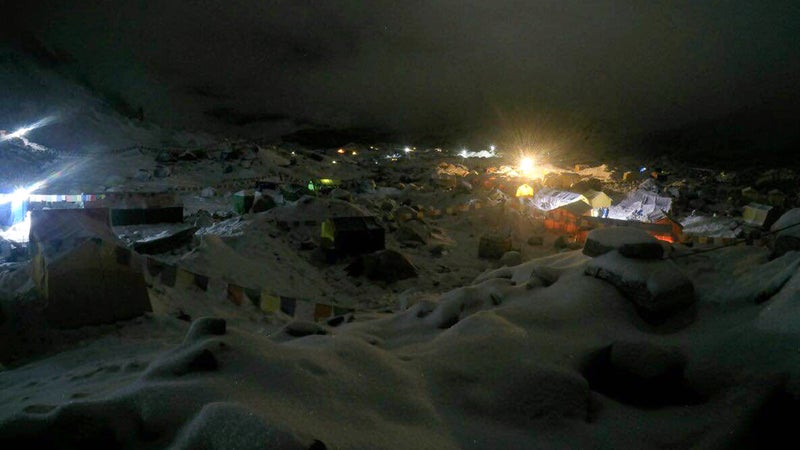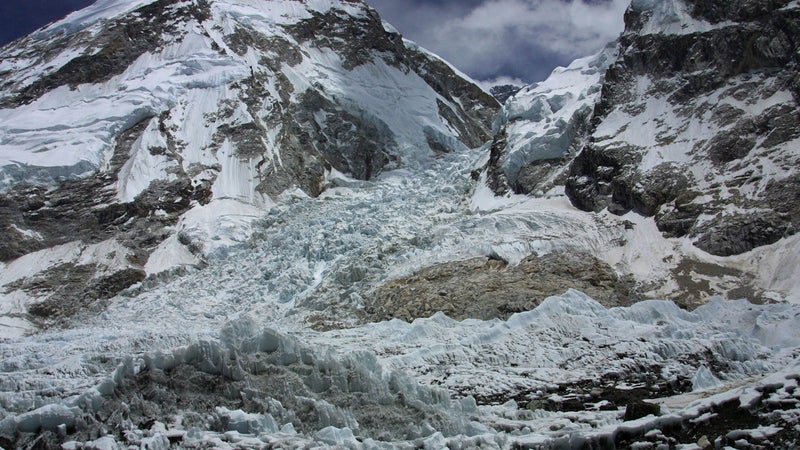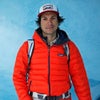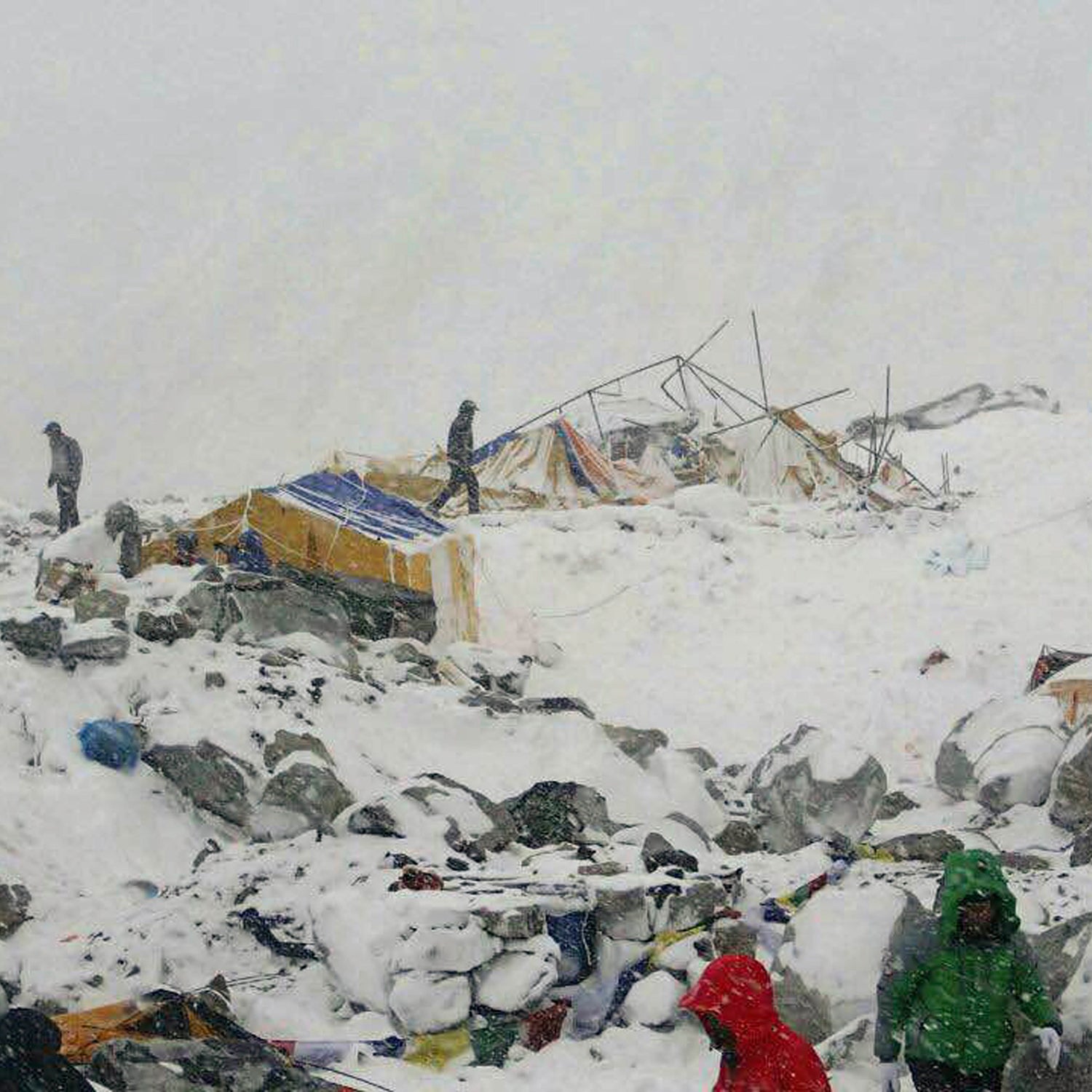If springtime on Mount Everest has taught us anything in the past three years, it’s to expect disaster from the most unlikely scenario you can conjure. Today, April 25, just before noon local time, with its epicenter roughly 50 miles north of Kathmandu. The death toll has already been reported at near 1,000��but is��certain to grow by multiples. The quake was the strongest to hit the country since an 8.2-magnitude earthquake struck in 1934, destroying many building in Kathmandu and killing up to 12,000 people. The Kathmandu Valley is now home to 1.5 million, and its buildings are primarily constructed from unreinforced brick and concrete. ��
One hundred air miles northeast of Kathmandu, the village of Lukla sits at 9,000 feet and serves as the gateway to the Khumbu Region. Though early reports have been sketchy, several Sherpa climbers who are working on Everest’s north side,��in Chinese Tibet,��were able to confirm that homes in their villages in Nepal’s Khumbu region were also destroyed.
On Mount Everest, the quake caused hanging glaciers to fracture and release. Veteran guide Dave Hahn, who was at Camp I with his team from Seattle-based Rainier Mountaineering, phoned his office to check in unhurt, saying the quake had “resulted in avalanches off of all the mountains around us.” ��
The most significant of these fell from a hanging glacier on the northern shoulder of 23,494-foot Pumori, a prominent peak on the west side of Everest whose flanks form the basin where Base Camp sits. (If you're in Base Camp looking at Everest, it is directly behind you.)��The upper portion of Base Camp was blanketed by debris, with rocks and ice tearing through tents. Typically, Base Camp is insulated from avalanches by distance—camps are set back several hundred yards from any avalanche path—and by a series of sand-trap-like moraine lakes and hillocks that cut short any falling debris. But this was a hundred-year event.
International Mountain Guide partner Eric Simonson :
This saddle is at 20,177 feet and Everest Base Camp is at 17,585 feet, so the difference is 2,592 feet. The tons and tons of falling ice going this vertical distance created a huge aerosol avalanche and accompanying air blast that hit the upper part of Base Camp��and blew many tents across the Khumbu glacier towards the lower Icefall. Apparently the air blast and earthquake also caused many big rocks to shift, which were the cause of some of the crushing injuries suffered by climbers in the upper section of Base Camp. The camps farther down the glacier (like the IMG camp) were untouched. It is worth noting that, over many expeditions, we have never seen an avalanche in this area that was even remotely of this scale. It was truly a freak event caused by a tremendous��earthquake.
Early reports have put the death toll in Base Camp between eight and 18, with many more injured. One of the few photos of the scene showed a yellow mess tent with just its steel skeleton left standing.��The Himalayan Rescue Association (HRA) camp was badly damaged in the avalanche. Doctors and paramedics are currently using the International Mountain Guides camp as their base of operations. The Himalayan Experience camp is being used to house uninjured climbers who’ve lost their camps.
��

Over the radio from Everest’s North Side, climbers listened in on South Side rescue efforts. International Mountain Guides’ sirdar Ang Jangbu could be heard uncovering the injured and dead and calling for stretchers and more manpower. Several teams checked in safe at Camp I and II. Among these were Colorado’s Charley Mace and his group from New Zealand–based �����ԹϺ��� Consultants and Everest blogger Alan Arnette, who’s climbing Lhotse (it shares Everest’s first three camps) with Madison Mountaineering. “All of us in the Western Cwm are OK��but sketchy at best,” said Arnette in a .
“We don’t have the ability to travel right now,” said Rainier Mountaineering’s Hahn in his sat phone call from Camp I. “Good mountaineering sense dictates that we stay put and ride this storm out. It may take a little time, but we are OK. We are self-sufficient up here, and our concern is with our friends at Base Camp.”
There in the mess of ruined tents, communication has been limited as medical personnel focus on the task at hand. But roughly six hours after the quake and avalanche, doctors from Montana physician Luanne Freer’s Everest ER took a short break from their work to post an :
There has been an earthquake in Nepal, and a huge avalanche off Pumori covered many tents in base camp. Many of our friends in base camp have been seriously injured and killed and we are taking just a few moments away from our work with the suffering to let our personal friends and families know that the Everest ER team are all safe. With the help of nearly every able bodied friend in base camp, we moved our clinic to the IMG camp where we are caring for patients.
As night fell, the climbers in Base Camp were on their own. In the immediate aftermath of the avalanche, it had begun to snow and no helicopters were able to make flights in to evacuate the wounded. Medical personnel and volunteers planned to work through the night to triage and care for the injured.
Much is still unknown, but one thing was certain, the tragedy on Everest will be dwarfed by the widespread devastation in the region and in Kathmandu.
North Side of #everest in Tibet. Our thoughts are with our Sherpa's families and all those affected by the earthquake. #alpenglowexpeditions #teamissafe
What we do��know is this: In the coming days, Everest rescuers will face a serious shortage of resources as the country tries to dig out. And as with last year’s avalanche, which killed 16 local workers, the idea of continuing to climb after such a horrific tragedy is almost unthinkable, though it’s doubtless that somebody will try. There’s also a question of what will happen to expeditions on Everest’s north side, in Tibet. Many of the workers there are also Sherpas, whose homes and villages will have been affected by the quake.
Nepal, which sits at the tectonic boundary of the earth’s Indian plate and Eurasian plate, has always been seismically active. The same forces driving up the Himalayas by a fraction of an inch each year regularly produce earthquakes. But the country has been relatively lucky since 1988, when a 6.8 quake along the Nepal–India border killed 1,500 people and injured another 16,000.
Kathmandu, like Port au Prince, Haiti, is a city of nearly 1 million—with another half million in the outskirts. It’s built primarily from fired bricks packed from the red earth that’s scooped from the city’s east side. In the Himalayan villages of the Khumbu Valley, as well as near Pokhara, Rolwaling, and Langtang, the buildings are primarily constructed of quarried stone. Very little of the country’s infrastructure is built to withstand a serious earthquake. It’s a problem that experts have been warning about for years without success.
Just last week, in fact, some . Their concerns echoed a 2005 warning by then–U.S. Ambassador to Nepal James Moriarty, who told a seismic-preparedness conference “that another quake at the strength of the 1934 incident would leave 45,000 dead, 90,000 injured, and 600,000 homeless.” Kathmandu, with a population density of roughly 35,000 people per square mile, isn’t among the top 50 most crowded cities in the world, but specific neighborhoods, like Mahankal and Budhanilkantha, on the north side of town closer to the quake’s epicenter, are both more densely populated than the average and also more poorly constructed. ��
As of now, flights are being diverted from Kathmandu’s Tribhuvan International Airport, which has only one runway and nine parking gates to support the flood of international aid and evacuation flights that are now preparing to deploy to Nepal.
“We’ve been told that the airport is going to be operational from daylight for emergency flights,” says Dan Richards, the CEO of Boston-based Global Rescue, which provides air ambulance and evacuation services to its clients almost anywhere in the world. “It doesn’t sound like the damage [to the runway] was all that extensive.” Richards believes that the Global Rescue has at least 100 clients in Nepal at the moment, though many of them have been unable to check in.
Kathmandu has a ��including the Nepal International Clinic, Norvic, and CIWEC Travel Medicine Clinic, which are favored by westerners. All of them will be overwhelmed.
It’s against this backdrop of massive countrywide catastrophe that the unfolding disaster on Everest will develop.
As the sun rises on Everest this morning, the true scope of the damage will begin to take shape. With luck, the weather will allow both helicopter and fixed-wing flights.
According to longtime Everest forecaster Michael Fagin, of , Sunday morning local time on April 26��will provide the best chance for helicopter rescues in what he characterizes as a typical pre-monsoon pattern that gets worse throughout the day. “It does look like a brief window,” Fagin says from his Seattle base. The models show clouds and up to three inches of snowfall around Everest on Sunday afternoon with weather deteriorating on Monday and Tuesday. “One of the models is predicting up to ten inches of snow on one of those days,” says Fagin. “It doesn’t take too much moisture to generate that.”
The question now is how the injured will make it back to Kathmandu to waiting air ambulances. Walking is out will be almost impossible. The main airstrip for the region, at 9,000 feet in Lukla, is 38 miles downhill from Everest Base Camp. It’s at least a two-day walk over a trail that’s likely been damaged by the same types of slides that tore through Base Camp. There will also be a question of where resources are directed when tens of thousands of people will require medical attention.
“There are probably three-to-four dozen helicopters that get used by the private sector all the time,” says Global Rescue’s Richards. “Most of our resources are online and available. My expectation is that those flights will begin with daylight tomorrow.”
According to Richards, in disaster situations such as the Haiti earthquake, “It’s not uncommon for people who don’t live there to want to leave. And if they have the resources, they do leave.”

That will likely prove difficult for the climbers stranded at Camps I and II, who probably need help but aren’t in any immediate��danger. The treacherous route through the Khumbu Icefall—a series of aluminum ladders and safety lines that span yawning crevasses—was wiped out by the avalanche. Still, both of those camps are stocked with enough food to sustain the climbers in them. And after such a sizable earthquake—like the avalanche-control charges used by ski patrollers—more slides should be less likely. With efforts focused on evacuating the injured from Base Camp, it could be days before the route is reestablished.
In the daylight, rescuers and camera crews will now reach the outlying neighborhoods in Kathmandu closer to the quake’s epicenter, and more photos will emerge from Everest. The names of the dead in Kathmandu, the villages in the Khumbu, and in Base Camp will begin to trickle out. One that’s already been released is that of��.*
Elsewhere in the region, the roughly 350 climbers on mountains other than Everest will either begin to check in or raise concerns through their silence. There will be questions of whether ice dams that hold back many glacial lakes in the area will catastrophically burst .
For now, as the Everest ER docs signed off shortly after the avalanche, “We [have] very limited communications at the moment. Pray for Nepal, friends. Namaste.”


